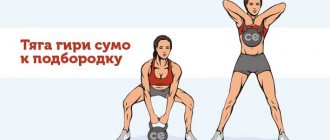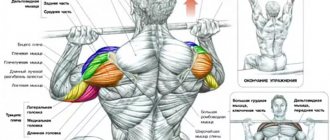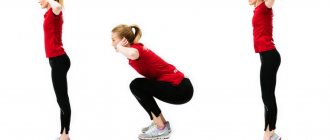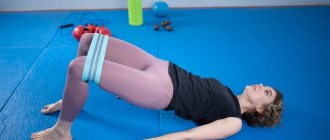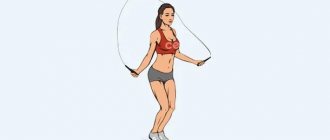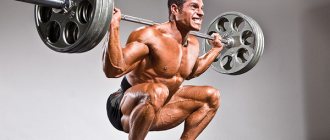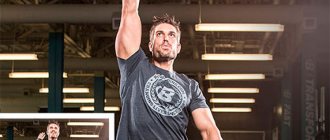The kettlebell swing is the first exercise that a beginning kettlebell lifter should learn because it does not involve lifting the kettlebell above your head, making it much more difficult to get injured. A swing with a kettlebell is a partial execution of a jerk, so you will perform it, at least as a warm-up, throughout all your classes with a kettlebell. Kettlebell lifting, like weightlifting, differs favorably from bodybuilding and powerlifting in that each exercise is basic and multi-component, so you can learn the technique of performing each of them step by step. You break the exercise into several parts and work on each of them separately, which also allows you to work on your weak points.
The kettlebell swing can be used even outside of special training with kettlebells, since the exercise very effectively accelerates blood circulation, warming up the muscles, and promotes the production of synovial fluid in the joints. As you understand, a good warm-up is designed But in order to be able to include swings in a warm-up or workout, you need to learn how to control the kettlebell. For this purpose, you should moderate your pride and take the smallest weight in the gym, most often it is 16 kg, but if there is a children's 8 kg weight in the gym, then you should use it. By the way, you shouldn’t think that the kettlebell is an exclusively male equipment; it can and should be used by girls, so if your girl is into fitness, be sure to get her used to the kettlebell!
The fact is that kettlebell exercises involve postural muscle layers, which is due to the fact that the kettlebell has a displaced center of gravity, therefore, to maintain balance, the body has to use all muscle groups. The main load, of course, falls on the superficial muscle layers, but only those muscles that are directly involved in the exercise, and to stabilize the skeleton, the body uses postural muscles, which are designed for this. Is this a good enough reason to include kettlebell swings in your training routine? Yes, if you want to maintain youth and increase your strength!
What muscles work when swinging kettlebells?
Swings or swings with a kettlebell are a multifunctional exercise that involves a large number of muscles and joints, develops endurance and strength. Thus, kettlebell swings will help burn fat when performing a high number of repetitions and maximum speed, that is, for a while.
In the first half of the range of motion, the quadriceps of the thigh and buttocks work, which contribute to pushing the weight out during the swing. The muscles of the abdomen and lower back are in static, that is, constant tension, which perform the function of protecting the spine from injury and also help push out the weight. In the lower position of the movement, the weight rises by inertia, thanks to the swinging of the body and pushing out by the pelvis. In the middle of the amplitude, the deltoid muscles, and to a greater extent the anterior bundles, are activated.
There are two ways to perform the exercise:
- Raising a kettlebell to a parallel line with the floor, such kettlebell swings are called Russian.
- Kettlebell overhead swings are used in CrossFit, this technique comes from the West.
The last option, from a technical point of view, is considered unjustified, since the deltas are no longer involved when moving above the parallel of the floor. However, this is the correct technique when meeting CrossFit standards.
Common mistakes
When performing kettlebell swings with two hands or training in another format, you need to avoid mistakes. Among the latest:
- performing swings if there are problems in the shoulder joints and/or lower back; ignoring this recommendation may aggravate the problems,
- training without warming up, warming up is warming up the muscles and ligaments, preparing the body for hard work, 10-15 minutes to prepare, and you will not only protect yourself from injury, but also increase the effectiveness of the exercise,
- weakening of the buttocks at the top point, at which the deltoids take the main load, relaxing the gluteal muscles, you lose control over the negative phase - the lowering is too sharp,
- too amplitude of the movement - the projectiles rise high above the head, for strength indicators and functionality the excessive trajectory does not give anything, but the risk of injuring the shoulders increases,
- lifting the heels off the floor, this leads to a loss of control over the kettlebell, as a result of which the apparatus outweighs the athlete - the back is rounded, and this is fraught with injury,
- moving away from the same line of the neck and spine, looking down or, especially, throwing your head back is not allowed,
- shifting the “responsibility” for movement to the hands, let us recall that the main part of the trajectory, the role of the hands is reduced to fixing the projectile.
Read also: How many steps a day should you take to lose weight?
Important!
- When swinging, the lumbar spine is subjected to a lot of stress; you must follow the correct technique, keep the abdominal muscles, lower back, and buttocks tense.
- Working with too much kettlebell weight can injure the shoulder joint; for this, select a moderate weight of the kettlebell.
- Do not round your back in the thoracic region, keep your shoulder blades tucked in, and do not twist your shoulders forward.
For injuries and diseases of the spine, kettlebell swings are contraindicated.
Execution technique
For those who are prepared, the technique will not be difficult. The technique is as follows:
- Take a slightly inclined position on bent legs.
- Raise the sports equipment from the front.
- Make a swing to shoulder level.
- Lower the weight.
Feet stand shoulder width apart. Bend your legs slightly and lean forward with your back straight. It is important to note that the shoulders are pulled back and the torso is pushed forward. This position is suitable for starting to lift the kettlebell from the floor.
The sports equipment is lifted from the front. The arms are extended. As the kettlebell rises from the floor, it is important to straighten your knees at the same time. The legs are straightened, the back is tilted to the floor, the head is raised up. At the same time, it is important to look forward with your eyes. Carefully select a point in the distance that will be located slightly above the horizon line.
Unlike some other techniques, with such swings the initial position itself requires concentration. If you lose one, you may get injured. In the initial position, the muscles of the abdomen and buttocks are already tense, and to a lesser extent – the back, legs, and neck. Of course, your arms are slightly tense.
Only after lifting the sports equipment, the body and arms are immediately directed downwards so that the sports equipment is under the pelvic area. If a person has long arms, the weight may go back behind the back. From this position, a forward swing is performed.
It is important to understand that during this exercise it will be wise not to stop at any of the final points of the amplitude of the sports equipment for too long. Otherwise, it is fraught with injury. It is enough that at the extreme point when jerking forward or swinging back, the sports equipment takes a split second. This is not difficult to do; it will take approximately this time to overcome inertia.
So, the weight is lifted from the floor, a backswing is made. The back at this moment is parallel to the floor. The sports equipment begins to fall under the influence of gravity, and at this moment a forward jerk is made. Previously, the weight was placed on the heels, but now it is transferred to the front of the feet. The knees bend slightly and then move forward.
The person contracts the muscles of the buttocks and makes a powerful and rapid movement of the pelvis. This imparts acceleration to the weight. The sports apparatus soars up to shoulder level. The arms are parallel to the floor, the back is straight. The weight shifted back again, although not to the same extent as in the bottom position. After this, the weight is lowered into a new swing.
If, while performing an exercise, pain or other discomfort occurs in the lumbar region or elsewhere, you should smoothly complete the exercise and lower the sports equipment. Then it is important to find out the cause of the problem.
Either the muscles are not yet sufficiently prepared for such a load, or the person has not warmed up properly, or there is a health problem. It is important to remember that a technique can bring both benefit and harm if you do not know how to perform it correctly.
Where to start for a beginner
Before starting to practice the exercise technique, warm up your muscles, ligaments and joints. Spend 7-10 minutes warming up (running, jumping rope). Stretch your glutes, glutes, and back muscles. Rotate your arms to warm up your shoulder joints, and also warm up your hip joint.
Perform the hyperextension exercise; this will stretch and tone the lumbar extensors, forming a protective “corset” necessary for training with kettlebells.
Choose a minimum kettlebell weight to begin with, work on the quality of your technique, not on your strength.
Remember , in order to perform swings efficiently, not only your back and abs must be strong, but also your legs, buttocks, and deltoids. Therefore, first you need to tone all your muscles in order to feel and correctly distribute the load on them.
Why a kettlebell?
The first question I ask a kettlebell training expert is: why kettlebell?
“Its advantage is that it is a projectile with a shifted center of gravity,” says Maria Larina. — For a dumbbell or barbell, it is located exactly in the center, but for a kettlebell it moves closer to the bottom, because there is a handle on top. This design allows the weight, unlike other projectiles, to seem to fly.” What's the use of a flying weight? Maria explains: training with a kettlebell involves smooth and rotational movements that are impossible with dumbbells. You have to not only work with weight, but also control the force of inertia. This requires more effort and - what is important - the effort of the whole body, rather than a separate muscle group .
“Kettlebell exercises are almost never aimed at isolated muscles,” says Maria. - At first glance, it seems that the arms are mainly working, but most often they are only a conductor of energy, and it is actually the abs, hips or buttocks that are working.
Kettlebell swings with two hands: technique
- Grasp the handle of the weights with both hands, place your feet slightly wider than your pelvis, with your toes slightly turned to the sides.
- Rock your body so that when you move forward, your pelvis seems to push your straight arms with the weight up. From the bottom point, the kettlebell starts moving between the thighs, from under the pelvis.
- As you push the weight up, tighten your glutes and straighten your knees and torso completely.
- Push the weight up to eye level, exhaling at the top.
- As you inhale, “throwing” the weight down, tilt your body forward so that the weight passes under your pelvis and, by inertia, returns upward, also completely straightening your torso.
Technique option No. 2
When swinging in CrossFit, the weight is pushed up to the top point above your head. Thus, also by inertia, the weight “flies” up and stops above the top of the head, forming a straight line of arms with the body. The body is completely straightened. When moving down, the weight is also placed under the pelvis.
CrossFit swing programs
And finally, a couple of examples of training programs that include kettlebell swings.
CrossFit complex FGS
| Exercise | Number of repetitions |
| Shwung with weights | 10 |
| Kettlebell swings with two hands | 10 |
| Burpee | 10 |
| Crunches (press) | 15-20 |
We continue to make you look like a jock.
Here and below photo pixabay.com
If you've been wanting to start training with kettlebells for a long time, but didn't know where to start, congratulations! You have found a comprehensive guide that contains the most basic exercises with a 16 kg kettlebell for all muscle groups. We hope you are ready to carefully absorb the information.
The kettlebell itself is a very useful sports equipment, which is ideal not only for strength training, but also for cardio training. Plus, a kettlebell will make you look as cool as possible, especially if you have a thick curly mustache, a tight tank top, and tights.
If you do all the exercises correctly and don’t neglect your workouts, pretty soon you will be able to notice how your functional strength, agility, balance and endurance are improving. In addition, you will definitely notice how much the relief of your body and muscles will change.
It’s worth noting right away that kettlebell training should not be classified as classic strength training aimed at muscle growth. The fact is that a set of exercises with weights is more aimed at developing motor actions, flexibility, speed and coordination. Therefore, you should not expect that with the help of a kettlebell you will swing to Arnie proportions. There will, of course, be an increase in muscle mass, but not a Halkov-like gain.
Nuances
There are several options. The main difference here is the grip. It is possible to divide the methodology into five options based on this criterion. In the first case, a grip is performed with both hands. In the second, the grip is done with one hand and the exercise is done with one hand.
In all other variations, the grip is also performed with one hand. However, in one case the hand changes during repetition, in another - with a high position of the kettlebell, in the third - with a high position of the kettlebell, but in a throw.
There are also a couple of additional options that are suitable for both one-handed and two-handed grips. It is possible to lower the kettlebell to the floor after a repetition, but it is possible to do without it. It is also possible to raise the arm differently, until it is perpendicular to the floor.
It turns out that the trajectory of the hand will be only half of the trajectory that is traversed in the classic version. However, you should not think that this method becomes much easier.
It is important not to forget that the jerk is performed primarily not by the arms, but by the hips and buttocks. This technique is aimed at strengthening the pelvis and legs. This program is suitable for both those who prefer light fitness and those who want to succeed in weightlifting.
The weight of the sports equipment is selected based on the person’s build, physical fitness and the person’s preferences in sports. If he is a fan of light fitness and sports games, swings with small sports equipment are better suited for him. It makes sense for a weightlifter to try something with more mass.
The classic swing method is also suitable for women. However, it is important to choose the appropriate weight and take into account your level of training and physical fitness. If a man gets injured during such an exercise, he will be able to correct the consequences over time. However, the woman has an impact on the organs associated with childbirth. Therefore, if the exercise is performed incorrectly, the consequences can be more serious.
What can be replaced
Such swings are a method that is not suitable for everyone. Firstly, this is working with more or less serious weight. Secondly, these are sudden movements. The combination of these two factors is already quite risky. Of course, if a person has problems with the joints, lower back, or cardiovascular system, this will not be suitable. However, replacing the exercise will not be difficult.
It is possible to perform a number of other actions that will strengthen the lower back, the back of the legs, and the deltoid muscles of the back. Classic squats are good for legs, when your feet are shoulder-width apart and do not leave the ground. During this exercise, the arms are raised straight forward while squatting. When a person gets up, he lowers his hands.
For the back muscles, exercises on the simulator for bringing together and spreading blocks are good. Proper setup will make the training safe and ultimately bring results. In addition, your arms will also be pumped up.
Regular bending and abdominal exercises are good for the belt. This will help blood flow in the area and strengthen the muscles. However, there will not be such a load as when swinging with sports equipment.
It is worth noting that swings are intended for those who want to achieve an above-average physical level. If a person’s task is simply to maintain the body in a healthy state, it is possible to do without swinging.
Also, the technique clearly should not be used for weight loss, because it will not give a significant result, and an overweight person can easily get injured during the process.
Turkish get up with kettlebell
Don’t forget about the difficulties, one of which is the Turkish get-up exercise with a kettlebell. It strengthens joints, makes ligaments elastic and, as usual, pumps up the muscles of the whole body. In addition, the Turkish get-up is very good for improving balance and coordination.
How to do:
Lie on the floor, bend your supporting leg (for example, your left) at the knee and get ready to grab the weight with your left hand. Pull the projectile towards you, and then straighten your left arm up with it.
Without lowering the weight, begin to rise up, leaning on your free arm and legs. Ultimately, you should be standing at full height with your arm extended above your head along with the kettlebell. Now try to return to the starting position (that is, lie down) with your arm still straightened.
Here the number of repetitions depends on your functionality. Perhaps five to seven repetitions will be enough to start with.
- Author: Dmitry Petrosyants
